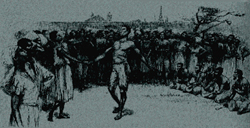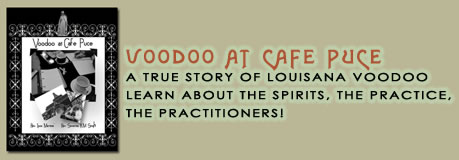NEW ORLEANS VOODOO CROSSROADS

A BRIEF HISTORY OF VOODOO
The practice of Voodoo is probably as old as the African continent itself. Sometimes written Voudou, Vodou or Voudun, the word itself means God Creator or Great Spirit. It has been greatly distorted and misused; human sacrifices, vampires, dripping blood and devil worship all make the stuff of spooky novels and Hollywood movies. Yet none of these originated with or ever belonged to Voodoo!
Voodoo is a life affirming practice that encourages its participants to better understand the natural processes of life and their own spiritual natures.
If one looks at the dictionary, Voodoo is likely to be defined as an ancient religion from Africa that involves the cult of Ancestors, of various animistic spirits, and the use of trances to communicate with such spirits. It is true that Voodoo did originate in Africa. Today it is practiced by millions throughout the world, in Africa, the Caribbean, Central, North and South America, in various forms, often with elements of catholicism mixed in. However, its main purpose remains as always to heal: to heal the individual in relationships within himself or herself, with others and ultimately with God.
Around 1510 the slave trade began, slaves being taken from the West Coast of Africa (Gulf of Guinea) from what is now Senegal and Gambia to the Congo region. The slaves who were torn from their native lands brought with them their beliefs and regional practices. Many were first brought to the Caribbean islands to work the plantations and be forcibly Christianized. Their owners ("masters") did not recognize the mystical qualities of their native ceremonies. Rather they considered them to be savages, incapable of abstract concepts or spirituality. Of course the denial of their humanity made it all so much easier to keep them as slaves. Yet in the terrible conditions of their enslavement, the Africans' only hope lay in their very faith. Amidst broken tribes and families, they found unity and solace in God and ancient rituals. It certainly also gave them a deep sense of inner freedom.
Although African slaves came from many different regions, most influential were the tribes from Nigeria and Dahomey. In 1729 the Dahomey conquered their neighbors the Ewes and sold their prisoners to the slave ships often in exchange for European goods. Many from Dahomey were also kidnapped. Both tribes had incorporated snake worship into their rites and some priests of the religion unwillingly found themselves on route to Haiti and the new world. Within one generation of their arrival, these priests had already established temples (hounfors) and developed a following in spite of their captivity and severe opposition of the French and Spanish churches. The term Vo-Du came from the Fons of dahomey. The other great influence came from Yorubaland (Nigeria), the site of the sacred city of Ile-Ife. Among the Yorubas, the Loa (Lwa or Spirits) are known as Orisha. Other people that contributed to modern Voodoo in the new world are the Aradia, Nago, Ibo, Congo, Senegalese, Mandingo, Ethiopians, Sudanese and Malgaches.
The Voodoos believe in the existence of one supreme God, a very abstract, omnipotent yet unknowable force. Below this almighty God, Spirits or Loa rule over the world's affairs in matter of family, love, happiness, justice, health, wealth, work, the harvest or the hunt etc. Offerings are made to the appropriate Loa to ensure success in those areas. Each Loa has its preferred fruits or vegetables, color, number, day of the week, etc. The Loa also manifest through elements of nature such as the wind and rain, lightning and thunder, the river, the ocean, springs and lakes, the sky, the sun, certain animals, trees and stones. Furthermore every element of nature, animal, tree, plant, fruit or vegetable is sacred to a certain Loa or Orisha.
Ancestors are consulted for guidance and protection. A rich and deep body of mythology and tales exists attesting to the amazing memory and poetic ability of the "Griots" who passed it orally from elder to youth and so on throughout the ages. It is truly a remarkable body of spirituality and a code by which African life was ruled. A very complex system of divination also exists known as "Ifa". It is said that the word Loa or Lwa itself derives from the French "Loi" (Law).
Upon their arrival in the West Indies and the New World, the slaves found themselves unable to continue the practice of their ancestral rites, sometimes under penalty of death. But they quickly understood the essential similarities between their beliefs and those of the Catholics; the Catholics praying to their Saints to intercede to a higher God in their favor. That is in fact the exact criteria used to "make a Saint", the ability to obtain miracles. A substitution took place: the Loa often taking the name and some of the attributes of the Saints. The elaborate ceremonies and costumes of the church also had great appeal for the Africans. I do not think that the Africans and their descendants would have seen it as a direct substitution rather than as an added path of expression of their deep-seated faith and beliefs.
In the Spanish Islands, the new religion became known as Santeria (the worship of the Saints). In other islands and in New Orleans, the term Voodoo remained. Because of its unique blend of French, Spanish and Indian cultures, New Orleans offered a perfect setting for the practice and growth of Voodoo. In 1809 many Haitians who had migrated to Cuba during the Haitian revolution found themselves cast out and came to New Orleans. They brought with them their slaves who incorporated their rites and beliefs to those of the existent slave population - Africans from Senegal, Gambia and Nigeria previously brought to Louisiana by the Companie des Indes. Voodoo in Louisiana was enriched and revitalized. It also incorporated the worship of the Snake Spirit (Damballah Wedo / Aida Wedo). To the Africans Voodoo was not only their religion, it was also their natural medicine, their protection and certainly a way of asserting and safeguarding a sense of personal freedom and identity.
Today about 15% of the population of New Orleans practices Voodoo. Modern Voodoo has taken several directions: Spiritualist Reverends and Mothers who have their own churches, Hoodoos who integrate and work spells and superstitions, elements of European witchcraft and the occult, and traditionalists for whom the practice of Voodoo is a most natural and important part of their daily lives, a positive search for ancient roots and wisdom. The practice of Voodoo involves the search for higher levels of consciousness in the belief that -as indeed all of the ancient scriptures teach - it is we who must open the way towards the Gods. for when we call out from our hearts, the Gods hear and indeed are compelled to respond. Voodoo is a powerful mystical practice between (Wo)Man and God thus saving him/her from further estrangement from the very universe that (s)he is born into.
(Copyright 1994 N.O. Voodoo Crossroads. Severine Singh) Published by Black Moon Publishing, Cincinnati, OH.

In 2004 Rev. Louis Martinie and Rev. Severina traveled to Paris for a week. Their travel log and journal became an essay on Voodoo, the Ancestors, healing the past and the Myth of Sisyphus. Lavishly illustrated with graphics and photographs of Paris and Louisiana. Voodoo at Cafe Puce has been offered in a signed and numbered special edition. A unique document by two of the foremost Voodoo practitioners in New Orleans today. A must-read for anyone interested in Voodoo and New Orleans culture at the very time when it is endangered.
Click here for more info and to order
LOUPGAROUROAD.COM : LOUISIANA AND VOODOO ART
Paintings, Photographs and mixed media art by Rev. Severina.


